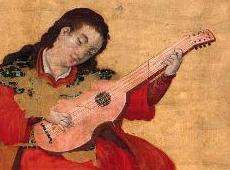Japanese woman playing the vihuela
(1590/ca) - Kobe Municipal Museum, and Yamato Bumko Museum, Nara, Japan
instrument: vihuela de mano | century: 16cent/3/late | catalogue nº: 16-303

Artwork
Creator anon
Medium Artwork: Painting
Location
City Nara, Kobe | Region Japan | Old kingdom
Characteristics
| Body Corners | Strings 5 courses | Neck Long | Pegbox Angled flat |
| Bridge Fixed | Frets | Back | Pegs Rear |
| Technique Plucked fingers |
Commentary
ARTWORK
Painted on paper glued to cloth. There seem to be more than one copy of this painting. The one shown here is from the Kobe Municipal Museum, given to me by David Irving on 23 July 2001, sent to him by Isaku Ogawa, and attributed to Nobukata. Another copy is in the Yamato Bumko Museum (photographed by Carlos González who gave me a slide of this in about 1999) in Nara, a museum established in 1961.
A photo reproduced in an article in 1977 Gendai Guitar magazine (omata1977) suggests that the picture has been restored. Batov’s website (http://www.vihuelademano.com/rcmdias.htm) gives also another version of the same painting in which the Japanese vihuelist is observed by a European man (16-303a)
INSTRUMENT
Japanese woman reclining playing a five-course vihuela. Oval body with shallow cornered waists. Bridge at base of instrument. Single soundhole high on belly. Similar to late 15th-century style. The playing pose and the instrument shape recall much earlier Spanish paintings such as the one attributed to Rodrigo de Osona (16-115). The rose is placed very high on the soundboard and the pegbox has the pegholes arranged as 4 pairs and a single hole at the top of the peg head. (see reproduction and commentary by Alexander Batov at http://www.vihuelademano.com/rcmdias.htm). For further details see Minamino (minamino1999-1, 41-50). The presence of instruments such as this in Japan attests to the influence of the Jesuits in Japan in the latter sixteenth century. The question remains as to whether Japanese painters were copying European paintings and incorporating Japanese figures, or if there was some fashion playing the vihuela in Japan during the period of Jesuit presence.